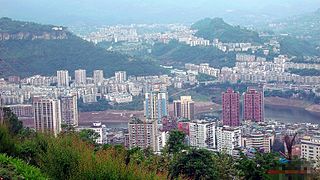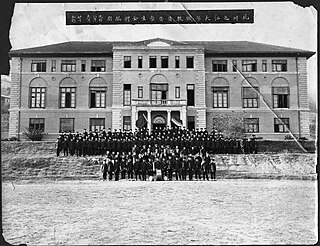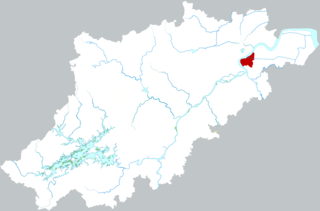
Chongqing is a direct-administered municipality in Southwestern China. Chongqing is one of the four direct-administered municipalities under the Central People's Government, along with Beijing, Shanghai, and Tianjin. It is the only directly administrated municipality located deep inland. The municipality covers a large geographical area roughly the size of Austria, which includes several disjunct urban areas in addition to Chongqing proper. Due to its classification, the municipality of Chongqing is the largest city proper in the world by population, though Chongqing is not the most populous urban area.

Wanzhou District is Chongqing's second most populated urban core area on the upper reaches of the Three Gorges of the Yangtze River in China. It is currently governed as a district of Chongqing Municipality, bordering Sichuan to the northwest and Hubei to the southeast. It was formerly known as Wanxian or Wan County. Prior to Chongqing's formation as a direct-controlled municipality, Wanzhou was part of Sichuan province. The urban core of Wanzhou is 228 km (142 mi) away from Chongqing's city proper.

Shapingba is a district of Chongqing, People's Republic of China, formerly known as Shaci District during the Sino-Japanese War. It is one of the central parts of Chongqing and covers around 396 square kilometers, with 13 subdistricts and 11 towns. Shapingba is one of the most populated areas in Chongqing with a population of around one million.

Quzhou is a prefecture-level city in western Zhejiang province, People's Republic of China. Sitting on the upper course of the Qiantang River, it borders Hangzhou to the north, Jinhua to the east, Lishui to the southeast, and the provinces of Fujian, Jiangxi and Anhui to the south, southwest and northwest respectively. Its population was 2,276,184 inhabitants as of the 2020 census of whom 902,767 lived in the built-up area made of Qujiang and Kecheng urban Districts. Chinese actress and singer Zhou Xun was born in Quzhou.

Hangzhou Bay is a funnel-shaped inlet of the East China Sea, bordered by the province of Zhejiang and the municipality of Shanghai, which lies north of the Bay. The Bay extends from the East China Sea to its head at the city of Hangzhou, from which its name is derived.

Aedas is an architectural firm founded by the Welsh architect Keith Griffiths. Aedas has eleven international offices and provides services in architecture, interior design, urban design, masterplanning and graphic design. It was established in 2002.

Hangchow University, also spelled as Zhijiang University and formerly known as Hangchow Christian College, Hangchow College, and Hangchow Presbyterian College, is a defunct Protestant missionary university in China, which is one of the predecessors of Zhejiang University. Founded as the Ningpo Boys' Boarding School by Divie Bethune McCartee and colleagues of Northern Presbyterian Church in Ningbo in 1845, the university was one of the oldest missionary schools in China before it was shut down in 1952. The university was merged into Zhejiang University and other universities in China. Its campus was taken over by Zhejiang University as its Zhijiang Campus in 1961, which became a major nationally protected historic site in 2006.

is one of ten urban districts of the prefecture-level city of Hangzhou, the capital of Zhejiang Province, in East China, it is located in the core urban area of Hangzhou. It is across the Qiantang River from West Lake and the older parts of Hangzhou. Like Pudong in Shanghai, it a very modern, and rapidly developing, area that was mostly farmland until ten years ago. The district's total area is 72.2 square kilometres (27.9 sq mi), and its permanent population totals 503,859 people as of 2020. The district people's government is situated on Xixing Road.

Kaihua County is a county under the jurisdiction of Quzhou city in Zhejiang Province of the People's Republic of China. It is located in the westernmost portion of Zhejiang, and is the source of the Qiantang River. The district's total area is 2224 square kilometers, and its population is 340,000 people. The district's postal code is 324300. The district government is located at 54 Jiefang Street, in the town of Chengguan. Forests cover 79.2% of Kaihua County, making it a key county for forestry in Zhejiang and in China as a whole.

Hejiang is a county in the southeast of Sichuan Province, China, bordering Guizhou province to the south and Chongqing Municipality to the north and northeast. It is under the administration of Luzhou city.

Jianggan District was one of ten urban districts of the prefecture-level city of Hangzhou, the capital of Zhejiang Province, East China. The district was located in the northeast of Hangzhou and on the northern (left) bank of the Qiantang River.
Hongshandian is a town of Shuangfeng County in Hunan, China. It has an area of 55.29 km2 (21.35 sq mi) with a population of 49,000. The town has 22 villages and 3 communities under its jurisdiction.

The Qiantang River, formerly known as the Hangchow River or Tsientang River, is a river in East China. An important commercial artery, it runs for 459 kilometers (285 mi) through Zhejiang, passing through the provincial capital Hangzhou before flowing into the East China Sea via Hangzhou Bay south of Shanghai. Its original name, the "Zhe River" or "Zhe Jiang", is the origin of the name of Zhejiang province. The river is also known, along with Hangzhou Bay, for having what is called by locals as the "Silver Dragon", the world's largest tidal bore, a phenomenon where the leading edge of the incoming tide forms a wave that can rise to a height of 9 meters (30 ft) and travels up the river or narrow bay at top speeds of 40 km/h against the direction of the river or bay's current, and can be seen from miles away.
Yanjing Beer 2018 Chinese FA Cup was the 20th edition of the Chinese FA Cup. On 29 December 2017, Yanjing Beer extended their sponsorship contract for another four years (2018–2021).
The 2018 Chinese Football Association Member Association Champions League, former known as Chinese Football Association Bing League (中国足球协会丙级联赛) and Chinese Football Association Amateur League (中国足球协会业余联赛) (2006–2017), is the fourth-tier football league of the People's Republic of China. The league is under the auspices of the Chinese Football Association.
Yanjing Beer 2019 Chinese FA Cup was the 21st edition of the Chinese FA Cup. The cup title sponsor was Yanjing Beer. For the first time, entrants were not seeded and there were separate draws for each round.

Qiantang District is a district in Hangzhou, the capital of Zhejiang Province in China. In August 2019, the Hangzhou Qiantang New Area, a provincial-level new area in Zhejiang established, and later has been transformed into a new area and integrated with the Hangzhou Economic and Technological Development Zone, a national-level development zone established in 1990. A district was established on April 9, 2021, with a total area of 531.7 square kilometers.
The 2022 Chinese Champions League, officially known as the Wisense Life 2022 Chinese Football Association Member Association Champions League for sponsorship reasons, was the 21st season since its establishment in 2002.














